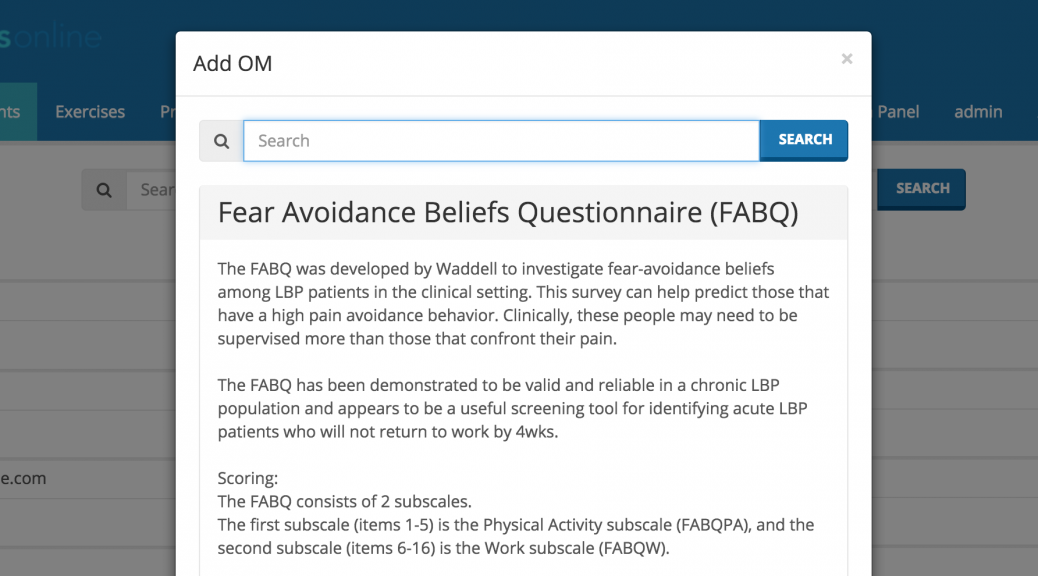The Fear Avoidance Belief Questionnaire (FABQ) was developed by Waddell to investigate the fear-avoidance beliefs of patients with chronic low back pain.(1) The Rehabilitation Measures Database states that the FABQ “focuses specifically on how a patient’s fear-avoidance beliefs about physical activity and work may affect and contribute to their low back pain (i.e. the cognitive/affective components of pain that are differentiated from specific tissue damage, injury, and nociception) and resulting disability.”(2)
The FABQ has been demonstrated to be valid and reliable in a chronic LBP population and appears to be a useful screening tool for identifying acute low back pain patients who will not return to work by 4 weeks. (1,3)
The FABQ consists of 2 subscales:
- The Physical Activity subscale (FABQPA)
- FABQPA of 15 or greater is considered a high score.
- The Work subscale (FABQW).
- FABQW of 34 or greater is considered a high score.
A patient with work related low back pain and a “positive” FABQ-W test result (score >34) has a higher probability of not returning to work in four-weeks.
Not only can the FABQ help determine the probability of current and future work loss and disability, the FABQ can also help healthcare professionals choose clinical interventions that have an increased probability of a successful outcome (i.e. the FABQ can predict successful outcomes from clinical interventions or predict decreased probability of successful outcomes).
For example, the FABQ can be used for the following clinical prediction rules:
- Sacroiliac Joint Manipulation
- A low FABQW score (less than 19) is one of 5 variables in a clinical prediction rule that increased the probability of success from sacroiliac region manipulation in individuals with low back pain.(4)
- Stabilization Exercise
- A low FABQPA score (less than 9) would decrease the probability of success of a stabilisation exercise program in individuals with low back pain.(5)
- A predictor of 6-month outcomes following 4-weeks of physical therapy.
- FABQW scores greater than 20 indicated an increased risk of reporting no improvement in 6-month ODQ scores.(6)
*The Oswestry Disability Questionnaire (ODQ) is considered the ‘gold standard’ of low back functional outcome tools.
In conclusion, healthcare professionals should be administering the FABQ within clinical practice. The FABQ can help determine the probability of current and future work loss and disability, as well as indicate increased risk of poor treatment outcomes. Practitioners utilising manipulation and exercise therapy in the management of low back pain, can derive information from the FABQ to determine the probability of success – or lack thereof – when deciding to implement these two clinical interventions.
Easily administer, score and interpret outcome measures – including the FABQ – through Erepsonline. For more information on selecting and viewing outcome measures, see the Erepsonline Video Tutorials, or check out the Quick Start Quide
References:
- Waddell G, Newton M, Henderson I, Somerville D, Main CJ. A Fear-Avoidance Beliefs Questionnaire (FABQ) and the role of fear-avoidance beliefs in chronic low back pain and disability. Pain 1993; 52:157-168
- Mordini N. (2014, June). Rehab Measures: Fear-Avoidance Beliefs Questionnaire. Retrieved from: http://www.rehabmeasures.org/Lists/RehabMeasures/PrintView.aspx?ID=1200
- Fritz JM, George SZ, Delitto A. The role of fear-avoidance beliefs in acute low back pain: relationships with current and future disability and work status. Pain 2001; 94:7-15. 3.
- Flynn T, Fritz J, Whitman J, Wainner R, et al. Clinical Prediction Rule for Classifying Patients with Low Back Pain Likely to Respond to a Manipulation Technique. Spine (Phila Pa 1976). 2002;27(24):2835-43.
- Hicks G et al. Prelimary Development of a Clinical Prediction Rule for Determining Which Patients with Low Back Pain Will Respond to Stabilization Exercise Program. Arch Phys Med Rehabil. 2005;86:1753-1762.
